

It's not easy being green: Ivanpah solar plant near Nevada burns a lot of natural gas, making it a greenhouse gas emitter under state law. A solar power plant at the center of the Obama administration’s push to reduce America’s carbon footprint has its own carbon pollution problem.

The administration’s initiative, which uses millions of taxpayer dollars to promote green energy, has been a boon for the Ivanpah plant in the Mojave Desert. But Ivanpah uses natural gas as a supplementary fuel, and data from the California Energy Commission show the plant burned enough of it in 2014 – its first year of operation – to emit more than 46,000 metric tons of carbon dioxide. That’s nearly twice the pollution threshold at which power plants and factories in California are required to participate in the state’s cap-and-trade program to reduce carbon emissions. The same amount of natural gas burned at a conventional power plant would have produced enough electricity to meet the annual needs of 17,000 California homes – roughly a quarter of the Ivanpah plant’s total electricity projection for 2014.
The U.S. Gas Limitations Plant and U.S. The World's Largest Solar Plant Started Creating Electricity Today. Ivanpah Solar Power Facility. The Ivanpah Solar Electric Generating System is a concentrated solar thermal plant in the California Mojave Desert, 64 km (40 miles) southwest of Las Vegas, with a gross capacity of 392 megawatts (MW).[5] It deploys 173,500 heliostats, each with two mirrors, focusing solar energy on boilers located on three centralized solar power towers.[5] Unit 1 of the project was connected to the grid in September 2013 in an initial sync testing.[6] The facility formally opened on February 13, 2014,[1] and it is currently the world's largest solar thermal power station.[7][8] The project was developed by BrightSource Energy and Bechtel.[9] It cost $2.2 billion; the largest investor in the project is NRG Energy, a power generating company based in Princeton, New Jersey, that has contributed $300 million.

Google has contributed $168 million.;[10] the U.S. government provided a $1.6 billion loan guarantee,[11] and the plant is built on public land. Description[edit] Awards[edit] Power towers[edit] Greenbiz. À 27 ans, elle fonde HOP pour dire « Halte à l’Obsolescence Programmée » ! The Alternative Energy Matrix. 4 views this month; 0 overall Breathe, Neo.
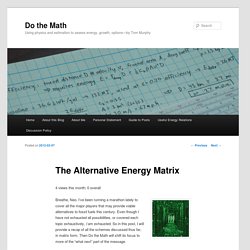
I’ve been running a marathon lately to cover all the major players that may provide viable alternatives to fossil fuels this century. Even though I have not exhausted all possibilities, or covered each topic exhaustively, I am exhausted. So in this post, I will provide a recap of all the schemes discussed thus far, in matrix form. Then Do the Math will shift its focus to more of the “what next” part of the message.
The primary “mission” of late has been to sort possible future energy resources into boxes labeled “abundant,” “potent” (able to support something like a quarter of our present demand if fully developed), and “niche,” which is a polite way to say puny. Cassandra's Legacy: How much for the sustainable energy transition? A "back of the envelope" calculation. Image source.
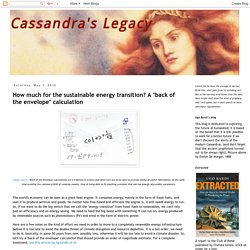
"Back of the Envelope" calculations are a tradition in science and often turn out to be able to provide plenty of useful information, at the same time avoiding the common pitfall of complex models, that of being able to fit anything provided that one has enough adjustable parameters. The world's economy can be seen as a giant heat engine. It consumes energy, mainly in the form of fossil fuels, and uses it to produce services and goods. No matter how fine-tuned and efficient the engine is, it still needs energy to run. Cassandra's Legacy: But what's the REAL energy return of photovoltaic energy?
Some time ago, a colleague of mine told me the story of when he had been in charge of the installation of one of the first photovoltaic plants in Italy, in 1984 (shown in the figure, on the right).
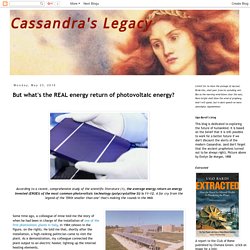
He told me that, shortly after the installation, a high-ranking politician came to visit the plant. As a demonstration, my colleague connected the plant output to an electric heater, lighting up the internal heating elements. The politician refused to believe that the heater was being powered by the PV plant. "There has to be a trick," he said, "this is not possible. MIT, Friday, Jan. Forget Energy Efficiency, Think Exergy. If we want to understand how to wring more efficiency out of our energy usage, we need to redefine energy use in the first place, argues a new study from the American Council for an Energy-Efficient Economy.

Thinking Big About Energy Efficiency. Observers of U.S. energy policy might think of energy efficiency as a useful investment strategy to smartly manage the growth of energy consumption.

They might also see it as a cost-effective means to ease our transition into a post-carbon world. Education Archives - Page 2 of 3 - Waste To Energy SystemsWaste To Energy Systems. 1.
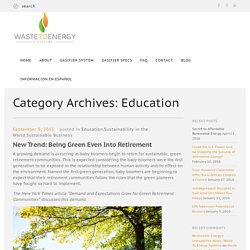
OysterBreakThe world is your oyster. At least it is for Tyler Ortego, Matt Campbell, and two professors at Louisiana State University, who invented the OysterBreak system in 2005 and brought coastal protection to life, literally. The system, which is essentially a chain of huge linked concrete cylinders, is made of an oyster-growing substrate that, once installed, is colonized by oyster larvae and eventually grows into a living reef. Because these solid reefs grow faster than sea levels rise, they reduce shoreline erosion.
ORA Estuaries, the company that Ortego founded in 2010 to run the building and distribution of the oyster reefs, recently won The Big Idea pitch competition at the 2015 New Orleans Entrepreneur Week. 2. 3. 4. 5. IEA Sankey Diagram. European Energy Flows Sankey. Energie. , quelles sont leurs performances, leurs impacts environnementaux et économiques et leur perspectives de développement ?

La recherche et développement, moteur d’une évolution technologique accélérée, notamment dans les domaines du photo-voltaique, de la biomasse et des moyens de stockage de l’énergie deviennent tout autant important que les capacités d’investissement et de déploiement. L’Acier. La fabrication d’acier remonte loin dans l’histoire de l’humanité.
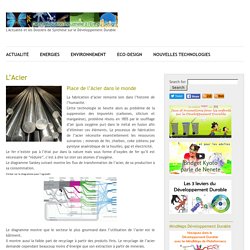
Cette technologie se heurte alors au problème de la suppression des impuretés (carbones, silicium et manganèse), problème résolu en 1855 par le soufflage d’air (puis oxygène pur) dans le métal en fusion afin d’éliminer ces éléments. Le processus de fabrication de l’acier nécessite essentiellement les ressources suivantes ; minerais de fer, charbon, coke (obtenu par pyrolyse anaérobique de la houille), gaz et électricité. Le fer n’existe pas à l’état pur dans la nature mais sous forme d’oxydes de fer qu’il est nécessaire de “réduire”, c’est à dire lui oter ses atomes d’oxygène. Le diagramme Sankey suivant montre les flux de transformation de l’acier, de sa production à sa consommation. Le diagramme montre que le secteur le plus gourmand dans l’utilisation de l’acier est le bâtiment.